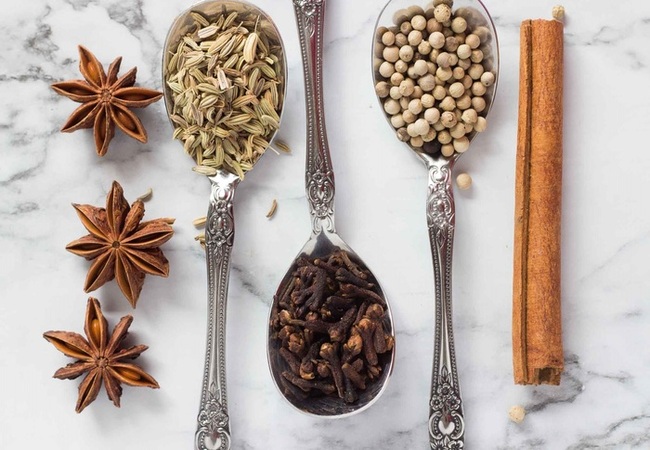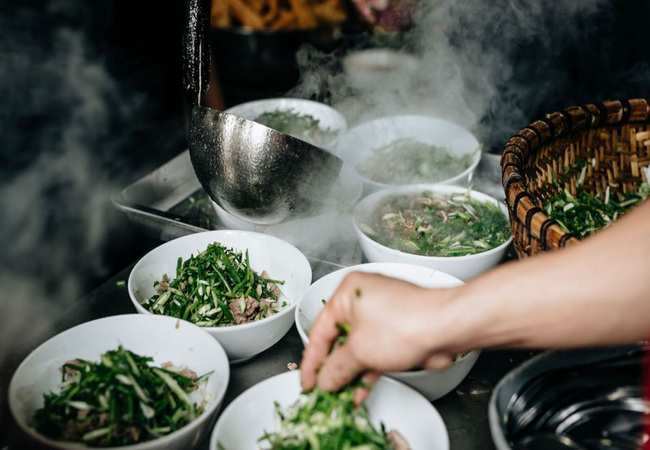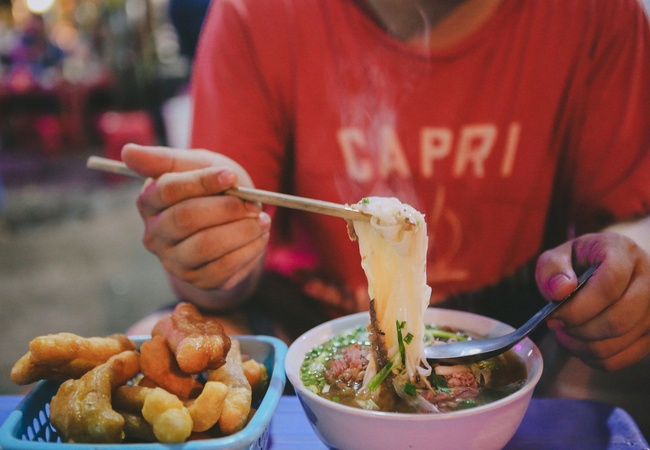I. The Introduction of Pho
1. History of Pho
Pho is a traditional Vietnamese soup that has gained worldwide popularity in recent years. Its origins can be traced back to the early 20th century in northern Vietnam, specifically in Hanoi. Pho was originally a street food, sold by vendors who carried their cooking equipment on shoulder poles and set up shop on the sidewalk.
The dish was created as a result of French colonial influence in Vietnam, which brought beef to the country, as well as the concept of cooking bones to create a rich, flavorful broth. The Vietnamese adapted this technique and combined it with their culinary traditions to create pho.
.jpg)
Pho in Hanoi Old Quarter
The first pho restaurants began appearing in Hanoi in the 1920s, and the dish quickly became popular among the working class. In the following decades, pho spread throughout Vietnam and eventually made its way to other countries as Vietnamese immigrants brought their cuisine with them.
Pho's popularity skyrocketed during the Vietnam War when American soldiers stationed in Vietnam were introduced to the dish and developed a taste for it. After the war, Vietnamese refugees who fled to the United States and other countries also helped to popularize pho.
Today, pho is a beloved dish in Vietnam and around the world, with countless variations and regional styles. It remains a symbol of Vietnamese culture and cuisine and is enjoyed by people of all backgrounds.
2. Importance of Pho in Vietnamese Culture
Pho is not just a dish but an integral part of Vietnamese culture. It has a special place in the hearts of Vietnamese people as it represents their country and their identity. Pho is enjoyed by people of all ages, classes, and backgrounds, and it is often considered the national dish of Vietnam.
Pho is not just a popular food item but a symbol of Vietnamese resilience and perseverance. It has survived the country's tumultuous history, including French colonialism, war, and economic hardships. The dish has even evolved over time to reflect changes in Vietnamese society and culture.
Pho is also an essential part of many Vietnamese traditions and customs. It is often served during important family gatherings and celebrations such as weddings, birthdays, and New Year's Eve. Pho is also an integral part of the Tet holiday, where it is served as a symbol of abundance and prosperity for the coming year.
In addition to its cultural significance, pho is also known for its health benefits. It is a nutritious and well-balanced meal that includes proteins, vitamins, and minerals. The use of herbs and spices in pho is also known to have medicinal properties that aid digestion, boost immunity, and provide relief from common ailments such as the common cold and flu.
II. Pho Hanoi Ingredients
1. The List of Necessary Ingredients for 2 Servings
- 500g beef bones
- 2 small pieces of ginger (about 2cm each)
- 1 medium onion
- 2 cloves of garlic
- 1 cinnamon stick
- 1 star anise
- 2 cardamom pods
- 2-3 whole cloves
- 2 tablespoons of fish sauce
- 1 tablespoon of sugar
- 1 teaspoon of salt
- 150g dried rice noodles
- 200g beef (sirloin, flank, or brisket)
- 2 spring onions
- 1 small bunch of fresh coriander
- 1 lime
- 2-3 red chilies
- Bean sprouts (optional)
- Thai basil (optional)

Importain Ingredients of Pho Hanoi
Note: Adjust the number of spices and seasoning to your taste preference. Also, feel free to add other ingredients such as beef balls or tendon, depending on your preference.
2. The Role of Each Ingredient
Each ingredient in pho plays an important role in creating the unique flavor and texture of this popular Vietnamese dish.
- Beef bones: The base of the broth is made by simmering beef bones for several hours. This creates a rich and flavorful broth that is the heart of pho.
- Onion and ginger: These aromatics are added to the broth to infuse it with additional flavor and aroma.
- Star anise, cinnamon, and cloves: These spices are often used in pho broth to add a warm, fragrant aroma and a touch of sweetness.
- Fish sauce: A key ingredient in Vietnamese cuisine, the fish sauce adds saltiness and umami to the broth.
- Sugar: A small amount of sugar is added to balance out the flavors in the broth and add a touch of sweetness.
- Rice noodles: These thin, flat noodles are a staple in Vietnamese cuisine and provide the bulk of the dish.
- Beef: Thinly sliced raw beef is added to the hot broth to cook it just before serving.
- Bean sprouts: Raw bean sprouts add a refreshing crunch to the dish and provide a contrast in texture to the noodles and beef.
- Thai basil: This herb adds a fresh, fragrant flavor to the dish and is often used as a garnish.
- Lime: A squeeze of lime juice adds a bright, citrusy flavor and helps balance out the richness of the broth.
- Jalapeño peppers: These peppers are often served on the side for diners to add as much or as little heat as they prefer.
Together, these ingredients create the complex and delicious flavor of pho that has made it a beloved dish around the world.
III. Preparation
1. How to Prepare the Beef Broth
- Roast the beef bones in the oven at 220°C for 30 minutes until browned.
- Fill a large stockpot with water and add the roasted beef bones and brisket. Cover with water and bring to a boil. Simmer for 10 minutes, then drain the bones and beef and rinse them under running water.
- Clean the pot and refill it with 6 liters of water.
- Add the bones and brisket, along with the onions and ginger, and bring to a boil.
- Reduce the heat to low and add the star anise, cinnamon sticks, cardamom pods, coriander seeds, fennel seeds, and black peppercorns.
- Simmer for at least 4 hours (the longer, the better), skimming the surface occasionally to remove impurities.
- Remove the beef brisket and slice thinly against the grain.
- Strain the broth through a fine-mesh sieve and discard the solids.
- Add fish sauce, sugar, and salt to taste.

The Preparation of Pho Hanoi
2. How to Cook The Rice Noodles
- Bring a pot of water to a rolling boil.
- Add the rice noodles to the pot and stir gently to separate the strands.
- Cook the noodles for 2-4 minutes, or until they are tender but still slightly firm.
- Drain the noodles in a colander and rinse them with cold water to stop the cooking process and remove excess starch.
- Divide the noodles into two serving bowls.
3. How to Prepare The Beef and Herbs
Pho Hanoi is a regional variation of the popular Vietnamese soup that is known for its clear, light broth and delicate flavors. Here's how to prepare the beef and herbs for Pho Hanoi:
- Beef: For Pho Hanoi, the beef is sliced thinly and cooked quickly in the hot broth. You can use beef sirloin, flank steak, or eye of round for this recipe. Freeze the beef for about 20 minutes before slicing it thinly against the grain.
- Herbs: The herbs used in Pho Hanoi are typically milder and less pungent than those used in other regional variations. They include Thai basil, cilantro, scallions, and sliced onions. Wash the herbs thoroughly and chop them into small pieces. Set them aside in a separate bowl.
IV. Serving
1. The Proper Way to Serve Pho
Serving Pho Hanoi is an important part of the experience, as it allows diners to customize their soup with herbs and garnishes. Here's the proper way to serve Pho Hanoi:
- Bring the bowl of Pho Hanoi to the table: Once the Pho Hanoi is assembled, bring the bowl of soup to the table.
- Add herbs and garnishes: Place a plate of Thai basil, cilantro, scallions, sliced onions, lime wedges, and sliced jalapeños on the table. Diners can add as much or as little of each herb or garnish as they like.
- Add sauces: Place bottles of hoisin sauce and sriracha sauce on the table. Diners can add a few drops of each sauce to their Pho Hanoi to add flavor and heat.
- Enjoy the Pho Hanoi: Use chopsticks and a spoon to eat the Pho Hanoi. The noodles can be twirled around the chopsticks and eaten with the broth, while the beef and herbs can be scooped up with a spoon.
- Finish the Pho Hanoi: Once the noodles are gone, diners can drink the remaining broth directly from the bowl.
By following these steps, you can serve Pho Hanoi in the traditional way and allow diners to customize their soup to their liking.

Visiter Enjoy A Hot Bow of Pho Hanoi
2. Tips for Customizing The Dish to Personal Preferences
Pho Hanoi is a versatile and customizable dish, allowing for personal preferences to be incorporated into the soup. Here are some tips for customizing Pho Hanoi to your personal preferences:
- Adjust the seasoning: The broth of Pho Hanoi can be seasoned to taste with fish sauce, sugar, and salt. If you prefer a more savory or sweeter broth, adjust the seasoning accordingly.
- Add more herbs: If you love the taste of fresh herbs, you can add more Thai basil, cilantro, or scallions to your Pho Hanoi. You can also add other herbs such as mint or coriander to the soup.
- Add different proteins: While thinly sliced beef is traditional in Pho Hanoi, you can also add other proteins such as chicken, shrimp, or tofu to the soup.
- Customize the garnishes: The garnishes for Pho Hanoi can also be customized. If you like more heat, add more sliced jalapeños or chili flakes. If you prefer a sweeter taste, add more hoisin sauce.
- Try different noodles: While rice noodles are traditional in Pho Hanoi, you can also try using different types of noodles such as egg noodles or udon noodles.
- Make it vegetarian or vegan: If you prefer a vegetarian or vegan version of Pho Hanoi, simply omit the beef and use vegetable broth instead. You can also use tofu or tempeh as a protein substitute.
By using these tips, you can customize your Pho Hanoi to your personal preferences and make it your own delicious creation.
V. Final Words
In conclusion, making Pho Hanoi at home is a fun and rewarding experience that allows you to customize the dish to your personal preferences. With the right ingredients and recipe, you can recreate the authentic flavors of Pho Hanoi in your own kitchen. So why not give it a try?
However, if you really want to learn how to make Pho Hanoi like a pro, we encourage you to visit Hanoi and experience the authentic flavors. In Hanoi, you can learn from local chefs and see how the dish is traditionally made. You can also explore the local markets and try different variations of Pho Hanoi. If you want to learn more about Vietnam cuisine you can read in our blogs here.
If you are planning a visit to Hanoi, let VietnamStay help create the most memorable journey, just leave us your request here.